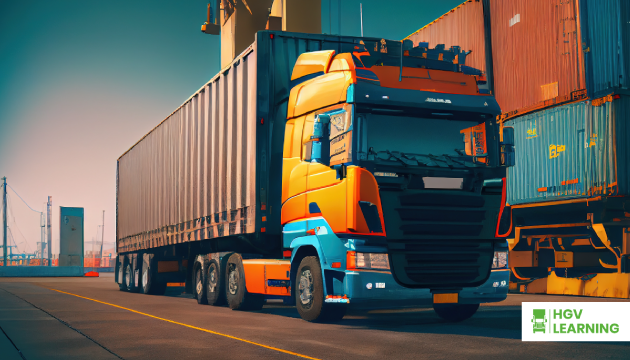Related Articles

28/10/2025
Preventing HGV Overloading: Legal Limits and On-the-Road Consequences

21/10/2025

The world of HGV safety technology has advanced rapidly in recent years. With more focus on road safety, driver support, and regulatory compliance, modern heavy goods vehicles now come equipped with systems that would have been considered cutting-edge only a decade ago.
These innovations aim to reduce accidents, improve visibility, and create safer working conditions for drivers and other road users. In this post, we explore the top HGV safety technologies being used today and why they matter.
HGVs are large, powerful vehicles that require high levels of skill and awareness to operate safely. Even small improvements in safety technology can make a significant difference in avoiding collisions, reducing blind spots, and alerting drivers to risks.
With stricter standards from the DVSA and growing public expectations, fleet operators are investing more in technology that helps reduce incidents and insurance claims. For drivers, these tools offer reassurance and reduce physical and mental fatigue over long journeys.
Advanced safety systems also help new drivers meet the expectations set out in Driver CPC training, ensuring they remain compliant and confident when operating large vehicles.
Blind spots are a major cause of accidents involving HGVs. Modern trucks now use radar or camera-based blind spot monitoring systems that alert drivers when pedestrians, cyclists, or vehicles are too close to the side of the vehicle. Some systems provide audible warnings or dashboard alerts to improve reaction times.
Lane departure warning systems use sensors to monitor road markings and detect when a vehicle drifts out of its lane. The system gives a warning sound or vibration through the seat or steering wheel. It’s especially useful on motorways and for drivers who cover long distances.
AEBS automatically applies the brakes if it detects a potential collision ahead and the driver does not respond in time. These systems can prevent rear-end accidents and are particularly effective in stop-start traffic or poor visibility.
Some vehicles are now fitted with multi-camera setups that give drivers a full 360-degree view around the vehicle. This is especially helpful when manoeuvring in tight urban environments or reversing into bays. It also supports better decision-making during deliveries.
Fatigue is a serious risk in long-distance driving. Driver monitoring systems track steering inputs, eye movements or head position to detect signs of drowsiness. If the system senses fatigue, it will alert the driver to take a break.
Digital tachographs not only track driver hours but can also issue real-time alerts for breaches in working time regulations. When integrated with telematics systems, they can alert fleet managers and prevent compliance failures before they occur. Learn more in our digital tachograph guide.
While not exclusive to HGVs, automatic headlights and wipers improve visibility by reacting instantly to changing light or weather conditions. This reduces the need for manual adjustments and allows drivers to focus on the road.
Speed limiters ensure that vehicles don’t exceed preset speed thresholds. Adaptive cruise control takes this a step further by adjusting the speed automatically based on traffic flow. This promotes smoother driving and reduces the likelihood of sudden braking.
TPMS helps drivers identify slow leaks, underinflated tyres or dangerous blowout risks. Correct tyre pressure improves handling and fuel economy and reduces the risk of tyre-related breakdowns. TPMS is particularly important when carrying heavy loads over long distances.
Some HGVs now come equipped with electronic stability control (ESC) and anti-rollover systems. These features work together to reduce the chances of vehicle rollover in sharp turns or during evasive manoeuvres. This kind of HGV safety technology is especially valuable when driving on uneven roads or through high winds.
Investing in HGV safety technology doesn’t just protect drivers – it improves efficiency and lowers costs. Key benefits include:
For new drivers, these technologies help build confidence. Knowing that the vehicle offers extra layers of safety makes the transition into the industry less intimidating.
Fleet operators looking to maximise uptime and reduce risk often combine vehicle technology with comprehensive training programmes to support continuous learning.
Technology alone is not enough. Drivers need training to understand how each system works and when to rely on it. During CPC training, safety features such as AEBS and tachograph systems are often discussed. For more on this, view our CPC certification guide.
Operators also play a role in creating a safety culture. Regular toolbox talks, system updates, and post-incident reviews help ensure that safety remains a shared responsibility.
Training also extends to back-office staff. Understanding what the technology does helps fleet managers interpret data accurately and respond to issues in real time.
HGV safety technology continues to evolve, making the roads safer for everyone. From blind spot monitoring to fatigue detection, modern systems are reshaping how HGVs are driven and managed.
Whether you’re a new driver or a seasoned operator, staying informed about the latest tools can help you get the most out of your vehicle. For expert training and resources, visit HGV Learning and take the next step in building a safer career.

28/10/2025

21/10/2025
Complete the form below and we’ll contact you asap.

